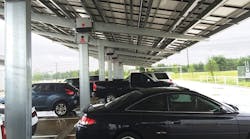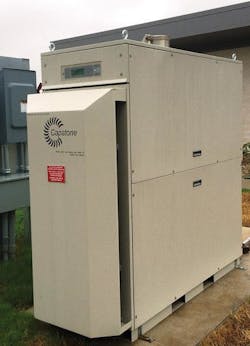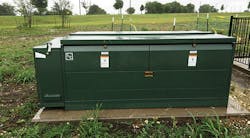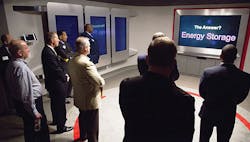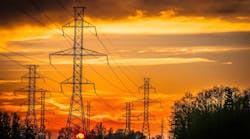Is it a laboratory? Is it an educational facility? Is it a smart grid? Is it green? Will it improve reliability? Will it create customer value? Yes is the answer to all of these questions.
At first glance, Oncor Electric Delivery’s System Operating Support Facility (SOSF) may look like any number of electric utility service centers across the country. It is a 100-acre (40.5-hectare) site with buildings designed to service transformers, meters and other equipment. There is open space set aside for equipment inventories and storage. From a distance, there is little to indicate it is home to a state-of-the-art microgrid facility. As soon as one enters the site and drives closer to Oncor’s new Environment Sciences Laboratory building, the view changes rapidly.
Pulling into the Environment Sciences Laboratory parking lot, visitors might think they have driven to a National Renewable Energy Laboratory test facility by mistake. The central feature of the parking lot is a solar photovoltaic (PV) array that also provides shade for parked cars. Glancing around, one also sees a Tesla battery bank, and further investigation reveals a second smaller PV array, a microturbine and an electric vehicle charging station. Although it is not a National Renewable Energy Laboratory project, the facility does represent one of the next logical steps in Oncor’s strategic vision.
A Storage Strategy
What led Oncor to pursue such a seemingly futuristic project? Like many utilities, Oncor is well aware of the significant change that has occurred and is still ongoing in the utility industry. In fact, Oncor’s existence is a result of the first waves of that change. A regulated transmission and distribution utility, Oncor was the by-product of Texas’ deregulation efforts that separated vertically integrated investor-owned utilities into competitive and regulated utilities.
Although deregulation efforts have significantly slowed in most parts of the U.S., Oncor was aware of changes accelerating in other areas. Changing consumer attitudes and the growth of distributed generation were among these. In 2014, the utility released a series of new strategic initiatives that included the installation of battery backup systems, microgrid development and customer service improvements that covered reliability and outage restoration efforts among others.
Oncor felt electric storage was a key element in these initiatives, but it was concerned about its cost, and sought to identify and harvest all the benefits. The wide range of prices being reported for batteries also caused concern, so the utility decided to do its own research to determine the cost of batteries today and get a feel for what might be expected in the future.
The storage research culminated in a study by the Brattle Group, an independent market research firm, found “…deploying electricity storage on distribution systems across Texas could provide substantial net benefit to the state.” With the Brattle recommendations in hand, and believing storage was on the cusp of commercial viability, Oncor moved quickly to begin a conversation with market participants, stakeholders and elected officials. The Brattle report identified up to 5 GW of distributed energy storage could be cost-effectively implemented at $350 per kilowatt-hour if both the market-facing and reliability value of storage could be enhanced. The forecasted amount dwarfed California’s goal of 1.3 GW by 2020.
Oncor also believes it is important to locate storage close to the customer in order to extract maximum value from the technology. The Brattle report estimated 65% of the benefit of storage on the grid would come from merchant energy benefits. These services would include both real energy arbitrage and ancillary services. The report also estimated 35% of the benefit could come from enhanced reliability. Interestingly, Oncor believes enhanced reliability benefits, or value, could be justified even if the battery capacity is only used 10% of the time.
However, Oncor was well aware that market participants were only in the preliminary stages of understanding the economic and reliability benefits of grid-scale energy storage, so they set out to begin a conversation. What began only a few short years ago has worked its way into the national conversation as an active and integral component of a 21st century grid. Across Texas, and much of the nation, market participants, stakeholders, regulators, legislators and consumer groups are all actively talking about the benefits of battery storage.
To help educate stakeholders and better promote the conversation on storage, Oncor developed a physical facility where visitors could see and experience the new technologies firsthand. From this recognition was born the Technology Demonstration and Education Center (TDEC).
TDEC-SOSF Integration
When exploring where the TDEC facility might be located, an opportunity presented itself. Oncor was planning on building the new Environment Sciences Laboratory at the Lancaster SOSF. In exploring this option, the utility discovered the SOSF presented other opportunities. Home to several mission-critical services, the SOSF periodically experienced outages that impacted operations. Also, as a wires-only utility, Oncor had to buy its power from the energy market just like its customers. These characteristics meant a microgrid might provide a real-world solution by enhancing reliability and reviewing the impact on the energy bill.
The decision was made to install the TDEC in the Environment Sciences Laboratory and integrate the microgrid into the SOSF power system. S&C Electric Co. and Schneider Electric were selected as the vendor partners and construction began on the new facility in 2014. Nine months later, Oncor was in the microgrid business.
Microgrid Configuration
Although many of the elements of the Oncor microgrid are visible, not all aspects are obvious. The SOSF was previously served at multiple secondary voltage meter points. During construction, these were consolidated behind one primary voltage meter. Then the SOSF grid was subdivided into four separate microgrids that could be operated separately or in unison depending on the situation.
Nine different energy sources are connected to the SOSF microgrid. The larger devices include 560 kW of legacy diesel generation capacity, a 65-kW propane microturbine, a 106-kW solar array over the parking lot and a 45-kW gas-powered reciprocating generator. A smaller west-facing solar array also is connected to test the potential alignment of solar generation with peak system demand that occurs on summer afternoons. There is sufficient distributed generation available to allow the 1.5-MW system critical applications to operate completely isolated from the utility grid if necessary.
Other distributed energy resources (DERs) include energy storage and load management. Battery systems include a 200-kW/400-kWh Tesla battery and a 25-kWh S&C PureWave Community Energy Storage product. The energy storage system plays the important role of providing the reference voltage and frequency when the microgrid is operating in isolation. Load management resources include heating, venting, air conditioning equipment and the electric vehicle charging station.
Schneider’s microgrid controller runs the Oncor microgrid, and S&C provided distribution switches that can be used to reconfigure the grid automatically. This combined control system can detect and isolate faults, and operate as an independent grid. Additionally, the utility anticipates capabilities to dispatch DERs and optimize energy purchases.
Oncor’s TDEC
Housed in the new Environment Sciences Laboratory building, the TDEC has two principle components: an immersion room and a demonstration center. Both contain impressive leading-edge media technology, with the immersion room offering multiple high-definition flat-screen displays that almost surround the viewer. Coupled with the video displays are fully integrated sound and lighting systems that provide an in-the-action feel to the room.
No stranger to severe weather, much of Oncor’s system is located in the southern end of the nation’s infamous tornado alley; and just so winter is not dull, north Texas often generates ice storms harsh enough to buckle the strongest overhead lines. To convey this impact, Oncor developed a short but intense multimedia presentation in the immersion room that allows the audience to experience (and feel) the evolution of a typical severe storm scenario, including lights out.
The presentation also details the impact of outages on customers and discusses the solutions electrical storage and microgrids might offer. A creative use of animated graphics and a dialogue mostly devoid of utility industry terms and acronyms allows nontechnical viewers to understand microgrid and storage operational concepts.
Not to be outdone, the demonstration center has a holographic display where an Oncor representative can appear in a device, reminiscent of a matter teleportation tube from a science fiction movie. In a prerecorded message, the representative explains the purpose of the TDEC, talks about what Oncor hopes to learn and discusses how knowledge will enable Oncor to serve its customers better in the future.
Along with housing the holographic display, the demonstration room serves as the control room for the microgrid. Several high-definition displays give the current operational status of the overall grid as well as the four sub-microgrids. Status also is readily available for all the major microgrid components. Reports show energy consumed, produced and saved all at a glance. Even while it is operational, the microgrid control system serves as a key show-and-tell element in the overall demonstration and education mission. It provides visitors with a real-time glimpse at how an advanced microgrid can tackle real-world energy problems and serves as a great example of a practical application of smart grid technologies.
Microgrid and TDEC Role
What is the role of this advanced facility going forward? Oncor still believes storage is a key element in the success of future utility grids and will be vital to provide the services customers will require and expect. Oncor also believes microgrids with integrated storage represent a singular opportunity to provide customers with energy solutions that can be tailored to meet their unique requirements. Oncor knows neither it nor anyone else has all the answers about the future, but believes its microgrid and TDEC provide the opportunity to explore that future and communicate what it finds to key stakeholders.
Oncor also will be using the microgrid and TDEC to test DER technologies. The utility will be examining how these technologies interact with the grid and how they might enable it to serve customers better. For example, Oncor wants to explore how advanced inverters might be used to feed volt-amperes-reactive into the grid, thereby offsetting some of the need for capacitor banks. Oncor will be developing test cases and use cases to determine how a portfolio of DER solutions might be combined to answer the problems grids will face in the future. It also wants to understand how the value of storage might be extracted fully for the benefit of the grid and the customer. There is much that needs to be explored, but Oncor feels the microgrid and TDEC will provide critical insights going forward.
As important as the SOSF installation is, the utility is not limiting phasing in of storage technologies to its microgrid and TDEC. It has begun testing 25-kWh storage devices strictly for reliability purposes. Installed at system locations with a history of reliability challenges, these devices help to keep the lights on for customers who are connected. Oncor believes the benefits resulting from reduced outages will prove such devices to be a cost-effective answer to reliability concerns.
A Back-to-the-Past Opportunity
Much has been written and said about the change the electric utility industry will experience over the next several decades. Anyone paying attention knows about the explosive growth of DERs and has heard about the threat of solar PV companies using storage to take utility customers off the grid.
In a way, this is a back-to-the-past kind of opportunity. The concept behind microgrids is not new. For example, data centers have long employed a form of microgrids to ensure extreme levels of electric service reliability. Today, it is the declining cost of solar PV, electric storage, and information and communications technologies that are opening so many more possibilities for microgrids.
Many have declared the grid has a terminal case of obsolescence. However, Oncor is not ready to retire the transmission and distribution grid just yet. In fact, the utility believes the grid will still offer great value to customers in the future, and it believes microgrids and electrical energy storage will play key and pivotal roles in delivering that future value.
Michael Quinn is vice president of strategy and CTO of Oncor Electric Delivery, charged with setting Oncor’s course in transforming the value of the electric grid through innovative, technology-driven and customer-focused solutions. His work impacts system performance and capital spending, legislative and regulatory efforts, customer engagement and future business model evolutions. Quinn joined Texas Utilities (Oncor’s predecessor) in 1988 and has had assignments in nuclear and fossil generation, system protection, asset management, transmission operations and business development. He holds a BSEE degree from Clemson University and is a registered professional engineer in the state of Texas. He is active on several trade associations and industry boards including energy storage, communications, transmission development and NERC compliance.John Baker is T&D World’s energy editor and president of Inception Energy Strategies, an executive consultancy serving the utility industry. He has particular expertise in strategic business models, new energy technologies, customer strategies and smart grid.